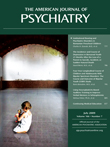Analysis of Mechanisms Underlying Depressive and Addictive Comorbid Disorders in Adolescents Should Not Ignore Nicotine Use and Dependence
To the Editor: In the March 2009 issue of the Journal , Uma Rao, M.D., et al. (1) tackled a very important issue pertaining to the comorbidity of affective disorders and substance use. The authors analyzed the role of stressors and urinary cortisol in predicting the onset of substance use disorders and depressive disorders in adolescents at risk, depressed adolescents, and healthy comparison subjects. Somewhat surprising was that the characterization of the participants did not include nicotine use and dependence, nor did the authors report that adolescents who smoked were excluded. Similarly, substance use disorder was a major outcome, but the most prevalent substance use disorder, tobacco dependence (2) , was not mentioned. Dr. Rao et al. did not cite an assessment instrument for nicotine dependence. Although the Schedule for Affective Disorders and Schizophrenia for School-Age Children—Present and Lifetime Version (K-SADS-PL) does assess nicotine consumption, it does not cover nicotine dependence. Actually, nicotine use and dependence are ignored by most psychiatric instruments (e.g., Schedules for Clinical Assessment in Neuropsychiatry, Mini-International Neuropsychiatric Interview).
Cigarette smoking has been discussed as a “gateway drug” to substance use disorders (3) . Furthermore, nicotine is a potent acute stimulator of the hypothalamic-pituitary-adrenal (HPA) axis through induction of corticotropin-releasing hormone release. Regular consumption of nicotine could therefore lead to chronically elevated adrenocorticotrophic hormone and/or cortisol levels (4) . Thus, it seems pertinent to discuss nicotine as a factor with a possible effect on several assessments within this study. Although the authors referred to a separate nicotine study they conducted, they did not mention or discuss nicotine use and dependence in their present study.
1. Rao U, Hammen CL, Poland RE: Mechanisms underlying the comorbidity between depressive and addictive disorders in adolescents: interactions between stress and HPA activity. Am J Psychiatry 2009; 166:361–369Google Scholar
2. Breslau N, Johnson EO, Hiripi E, Kessler R: Nicotine dependence in the United States, prevalence, trends, and smoking persistence. Arch Gen Psychiatry 2001; 58:810–816Google Scholar
3. Biederman J, Monuteaux M, Mick E, Wilens T, Fontanella J, Poetzl K, Kirk T, Masse J, Faraone S: Is cigarette smoking a gateway to alcohol and illicit drug use disorders? A study of youths with and without attention deficit hyperactivity disorder. Biol Psychiatry 2006; 59:258–264Google Scholar
4. Kudielka BM, Hellhammer DH, Wüst S: Why do we respond so differently? Reviewing determinants of human salivary cortisol responses to challenge. Psychoneuroendocrinology 2009; 34:2–18Google Scholar



